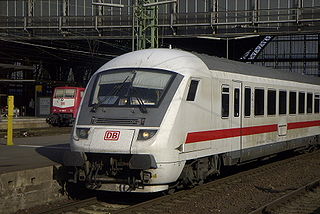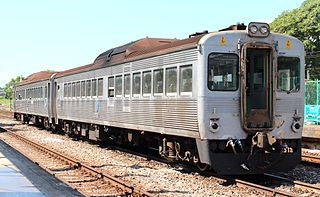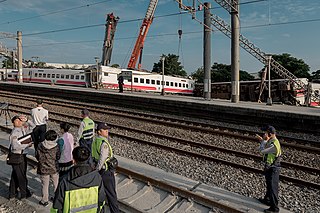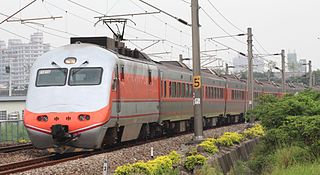
A diesel multiple unit or DMU is a multiple-unit train powered by on-board diesel engines. A DMU requires no separate locomotive, as the engines are incorporated into one or more of the carriages. Diesel-powered single-unit railcars are also generally classed as DMUs. Diesel-powered units may be further classified by their transmission type: diesel–mechanical DMMU, diesel–hydraulic DHMU, or diesel–electric DEMU.

The InterCity 125 (originally Inter-City 125) or High Speed Train (HST) is a diesel-powered high-speed passenger train built by British Rail Engineering Limited between 1975 and 1982. A total of 95 sets were produced, each comprising two Class 43 power cars, one at each end, and a rake of seven or eight Mark 3 coaches. The name is derived from its top operational speed of 125 mph (201 km/h). At times, the sets have been classified as British Rail Classes 253, 254 and 255.

The Budd Rail Diesel Car (RDC), also known as the Budd car or Buddliner, is a self-propelled diesel multiple unit (DMU) railcar. Between 1949 and 1962, 398 RDCs were built by the Budd Company of Philadelphia, Pennsylvania, United States. The cars were primarily adopted for passenger service in rural areas with low traffic density or in short-haul commuter service, and were less expensive to operate in this context than a traditional diesel locomotive-drawn train with coaches. The cars could be used singly or coupled together in train sets and controlled from the cab of the front unit. The RDC was one of the few DMU trains to achieve commercial success in North America. RDC trains were an early example of self-contained diesel multiple unit trains, an arrangement now in common use by railways all over the world.

The British Rail Class 201 six-car diesel-electric multiple units (DEMUs) were built in 1957–1958 at Eastleigh and underframes were built at Ashford.
Push–pull is a configuration for locomotive-hauled trains, allowing them to be driven from either end of the train, whether having a locomotive at each end or not.

Japan Transport Engineering Company (J-TREC) is a manufacturer of heavy rail cars in Japan, formerly known as Tokyu Car Corporation. The company is based in Kanazawa-ku, Yokohama, and a member of East Japan Railway Company group. J-TREC manufactures rail vehicles not only for JR East and Tokyu Corporation but for other Japanese operators, including various Japan Railways Group companies and international operators as well.

A control car, cab car, control trailer, or driving trailer is a non-powered rail vehicle from which a train can be operated. As dedicated vehicles or regular passenger cars, they have one or two driver compartments with all the controls and gauges required to remotely operate the locomotive, including exterior locomotive equipment such as horns, bells, ploughs, and lights. They also have communications and safety systems such as GSM-R or European Train Control System (ETCS). Control cars enable push-pull operation when located on the end of a train opposite its locomotive by allowing the train to reverse direction at a terminus without moving the locomotive or turning the train around.
Tze-Chiang, also Tzu-chiang or Ziqiang, is a type of limited express train service operated by Taiwan Railway (TR). Of the five service classes operated by TR, the Tze-Chiang service is the fastest. Ticketing is done on the basis of mileage.

The 900/800 class railcars were diesel multiple units built by the New South Wales Government Railways between November 1951 and November 1960.

The Taroko Express is an express train service of Taiwan Railway, and is part of Tze-Chiang Limited Express. The name of the service comes from the 19-kilometre (12-mile) long Taroko Gorge, which is one of Taiwan's most popular tourist spots, and the Truku people. It began commercial operations on 16 February 2007.

The Córas Iompair Éireann (CIÉ) 2600 Class were Associated Equipment Company (AEC)–engined diesel multiple units that operated InterCity and suburban services on the CIÉ system between 1952 and 1975. Many were later converted for push–pull operation with diesel locomotives, finally being withdrawn when displaced by the electric Dublin Area Rapid Transit service in the mid-1980s.

Diesel multiple units and railcars are trains, usually with passenger accommodation, that do not require a locomotive. Railcars can be single cars, while in multiple units cars are marshalled together with a driving position either end. As of December 2010, 23 percent of the rail passenger cars used on Network Rail are part of a diesel multiple unit.

The Taiwan Railway EMU100 series was a set of rail cars fabricated by British Rail Engineering Limited and the General Electric Company in 1976 that has operated in Taiwan. The alternating current electric multiple unit (EMU) fleet entered full squadron service in 1979, and was withdrawn from service in 2009. This class of railcars were the first to operate on the electric Tzu-Chiang Express. Due to the unit's British origin, rail buffs have variously nicknamed them "British Girl", "British Lady", or "British Grandma".

The DR2700 series, also locally affectionately known as the "White Steel Train", was a series of diesel multiple unit trains used by the Taiwan Railways Administration. They were originally built by Tokyu Car Corporation of Japan in 1966, in response to an order by the Taiwan Railways Administration, because of the need to renew the rolling stock on the by then 10-year-old Flying Formosan Express service.

The Puyuma Express is a type of railway service on Taiwan Railway (TR) notable for using tilting trains. It began commercial service on 6 February 2013 during the Spring Festival.

Taiwan Railway (TR) is a state-owned conventional railway in Taiwan. It is operated by the Taiwan Railway Corporation under the supervision of the Ministry of Transportation and Communications, responsible for managing, maintaining, and running conventional passenger and freight railway services on 1,097 km (682 mi) of track in Taiwan. Passenger traffic in 2018 was 231,267,955.

On 21 October 2018, a passenger train derailed in Yilan County, Taiwan, killing 18 people and injuring 187. At the time, it was Taiwan's deadliest rail accident since a collision near Miaoli in 1991 that killed 30 people.

The DR2900 series and DR3000 series is two series of diesel multiple unit trains operated by the Taiwan Railways Administration as Tze-chiang limited express on non-electrified mainlines. They were originally built by Hitachi in 1986(DR2900) and 1990(DR3000) for the Taiwan Railways Administration to provide more service on the eastern mainline of Taiwan. Although two trains are named with different numbers, they actually shared the same design.

The E1000 locomotive, commonly known as the PP Tze-chiang, is a series of electric push-pull trains used by the Taiwan Railways Administration (TRA), operated as part of the Tze-chiang limited express service. The locomotives were built by Union Carriage & Wagon and GEC-Alsthom, while the passenger cars were built by Hyundai Precision & Industries and Tang Eng Iron Works.

The Taiwan Railway EMU400 was an electric train purchased by Taiwan Railways Administration from South Africa in 1990 and is the first-generation of commuter electric train for Taiwan Railways. A total of 48 vehicles in 12 groups have been introduced, which have been put into commuter train services between Hsinchu and Keelung since the beginning of operation, replacing the non-air-conditioned commuter buses formerly used along the route. Due to the introduction of EMU800 series electric trains, all EM400 units have been withdrawn from service in 2015.




















